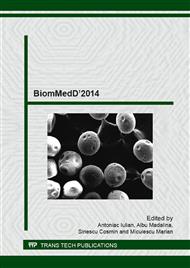p.123
p.130
p.135
p.141
p.145
p.151
p.155
p.161
p.165
Determination of Mastication Forces in Case of Total Dental Prosthesis
Abstract:
In whole wide world, lots of individuals lose teeth from different causes. In these cases, in first phase, a dental implant is the best solution. In some cases, as the last solution, a dental prosthesis is needed. To correct these disorders, rehabilitation treatments with adequate dentures, either fixed or removable, are indicated. [6] The forces that appear during mastication are influenced by occlusion type and space distribution of teeth. In case of persons that have a dental prosthesis the forces that occurred during mastication can be reduced if the dental prosthesis is correctly generated. A mastication simulator is any device that reproduces the conditions present during the process of chewing in order to reconstruct the complicated process of mastication outside the body. [5] The aim of this paper is to produce a device that can simulate the mastication and use it to determinate the mastication forces that appears during the mastication of different foods types. On the device that was build can be placed different dental prosthesis. [2] Using the device adjustment facilities we are able to simulate any type of occlusion. Using this device, a mechanical testing equipment and different types of food we are able to determinate the vertical force that occur. Base on these results we will be able to determinate if the dental prosthesis was correctly produced.
Info:
Periodical:
Pages:
145-150
Citation:
Online since:
March 2015
Authors:
Keywords:
Price:
Сopyright:
© 2015 Trans Tech Publications Ltd. All Rights Reserved
Share:
Citation:


